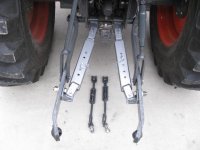jeff9366
Super Star Member
- Joined
- Jan 14, 2011
- Messages
- 12,787
- Tractor
- Kubota Tractor Loader L3560 HST+ ~~~~~~~~~~~~~ 3,700 pounds bare tractor, 5,400 pounds operating weight, 37 horsepower
What are the 3pt stabilizer bars and extendable/TELESCOPING 3pt LOWER LINK arms? WHAT ARE THE ADVANTAGES OF RIGID STABILIZER BARS Versus NON-RIGID CHAIN STYLE TURNBUCKLES?
Are these usually add-ons or do some of the tractors come with these? Are there different versions of 3pt hitch on these tractors?
The two lower arms on the Three Point Hitch are properly called the LOWER LINKS, often improperly called Lift Arms. The the end of each LOWER LINK arms there is an articulated "Bull's Eye" hole in which the corresponding lift pins on the implements fit, with minimal clearance. LOWER LINKS vary greatly in size/strength from tractor to tractor. With small/light tractors and corresponding light implements it is sometimes not too difficult to jockey the implement manually to line up the implement pins with the LOWER LINK bull's eye holes to mount the implement. (review: minimal clearance)
With heavier tractors you have to repeatedly back up the tractor until the bull's eye holes match up to the tractor implement pins, because (as you pass 50 years of age) the implements are too heavy to move manually. As a newbie, I often moved the tractor 6-8 times to achieve the match. Telescoping LOWER LINKS do just that, they telescope/extend longer so you do not have to move the tractor, the LOWER LINKS, including the bull's eye holes, extend/retract independently, three inches or so.
When an implement is mounted on the Three Point Hitch and you move over even slightly uneven ground the implement will swing and sway, hitting the moving tractor tires. Three Point Hitch stabilizers adjust to remove slack in the LOWER LINKS, preventing the implement from hitting the moving tires. So, after mounting implements it is usually necessary to adjust the stabilizers to remove slack relative the the specific width implement you intend to use. On economy tractors the LOWER LINK stabilizers are flexible turnbuckles, sort of like adjustable chains. You screw an adjusting nut on each side to remove LOWER LINK slack. Turnbuckles are strong PULLING with the tractor moving forward, but provide no support when when the tractor is in reverse, pushing an implement; rather the turnbuckles will bend, requiring replacement. (Replacement metric turnbuckles are absurdly expensive.)
Rigid, pinned stabilizers adjust easily by moving one pin on each side into a selection of holes, setting the desired LOWER LINK slack. Rigid stabilizers, if of heavy enough structure, provide almost the same support to implements whether the tractor is moving forward or in reverse. Pushing implements is most often and critically an issue operating Box Blades but same issues occur when using 180 degree reversed Rear/Angle blades and 180 degree reversed Landscape Rakes, which are pushed.
Both these quick, easy adjustments fittings require more complex and usually heavier LOWER LINKS + stabilizers therefore are more expensive to manufacture. See photo, below.
You will often drop and add implements during hot afternoons when your body is overheated from working.
If you are over age sixty or will be operating your first tractor after age sixty, avoid the potential for a heart attack, option the tractor for both telescoping LOWER LINKS and pin adjustable, rigid LOWER LINK stabilizers.
Photo: Aftermarket pin adjustable, rigid stabilizers {14.4 pounds} versus (bent) factory original turnbuckle stabilizers {3.7 pounds}.
LINK: http://www.tractorbynet.com/forums/...opic-stabilizers-check-chains.html?highlight=
Attachments
Last edited:
